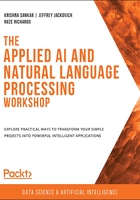
Introduction
Since 2005, when Amazon formally launched its Elastic Compute Cloud (EC2) web service, cloud computing has grown from a developer service to mission-critical infrastructure. The spectrum of applications is broad—most highly scalable consumer platforms such as Netflix are based on AWS, and so are many pharmaceuticals and genomics, as well as organizations such as the BBC and The Weather Channel, BMW, and Canon. As of January 2020, there are about 143 distinct AWS services spanning 25 categories, from compute and storage to quantum technologies, robotics, and machine learning. In this book, we will cover a few of them, as shown in the following diagram:

Figure 2.1: Amazon AI services covered

S3 is the versatile object store that we use to store the inputs to our AI services as well as the outputs from those services. You have been working with S3 since Chapter 1, An Introduction to AWS.

Lambda is the glue service that makes serverless computing possible. You will use Lambda later in this chapter to analyze text using Comprehend.

API Gateway is a delivery service that can enable you to create microservices that can be accessed by various clients, such as web, mobile, and server applications, via internet protocols such as HTTP, WebSocket, and REST. API Gateway gives you the ability to expose your microservices in a secure and scalable way. In the age of microservices and the "API-first" approach, the greatest challenge is the creation, publishing, monitoring, and maintenance of API endpoints. Almost all AWS services are APIs and use the API Gateway infrastructure.
Amazon's machine learning services, the main focus of our book, are a set of 16 services as of January 2020. They are also called AI services, and currently, the terms are interchangeable. Let's take a quick look at the ones we are interested in.

Comprehend, the topic of this chapter, is a very versatile text analytics service. It performs a variety of tasks—keyphrase extraction, sentiment analysis (positive, negative, neutral, or mixed), syntax analysis, entity recognition, medical Named Entity Recognition (NER), language detection, and topic modeling. You will see this in action later in this chapter.

Lex is a platform for building conversational AI, bots, or intelligent assistants. Conversational AI capabilities such as automatic speech recognition (ASR) and natural language understanding (NLU) are built into the Lex framework. Lex provides a very intuitive object model consisting of bots, utterances, slots, and sessions, as well as integration with Amazon Lambda, thus enabling you to develop interesting, intelligent bots in a serverless environment. We will see more of Lex in Chapter 4, Conversational Artificial Intelligence.

Personalize is a very useful service that allows you to personalize your bots. For example, incorporating personalized recommendations/content delivery, personalized searching based on previous interactions, or even personalized notifications and marketing based on user behavior! While we will not be using Amazon Personalize in this book, we wanted to bring your attention to services closely related to the ones covered in this book. That way, you can add extremely rich features as you expand the power of your bots and NLP services.

Polly is a text-to-speech service using neural text-to-speech (NTTS) technologies. It is very flexible and powerful, offering two styles: a newscaster reading style and a normal conversational style. The voice need not be monotone—Amazon Polly supports Speech Synthesis Markup Language (SSML), which enables you to adjust the speaking style, volume, speech rate, pitch, phrasing, emphasis, intonation, and other characteristics.

Textract, as the name implies, extracts text from documents. It is an optical character recognition (OCR) solution that is suitable for process automation. It can extract key-value pairs or tables from documents such as tax forms, legal documents, medical forms, bank forms, patent registration, and so forth.

Transcribe is a speech-to-text Automatic Speech Recognition (ASR) service and is very versatile; for example, it can recognize multiple speakers and you can filter out words. It is very useful in medical transcription, for time-stamped subtitle generation, and for transcribing customer interactions.

Translate is another very useful service that's able to translate more than 50 languages in a scalable, real-time fashion.

Rekognition, of course, is a visual analysis and image detection service capable of a variety of tasks, such as facial recognition, video analysis, object detection, and recognizing text in images. Chapter 6, Computer Vision and Image Processing is dedicated to Amazon Rekognition.

Unlike the AI services we have looked at so far in this chapter, Amazon Connect is a very feature-rich contact center application. It consists of an omnichannel cloud contact center with high-quality audio, web/mobile secure chat, and a web-based contact control panel. The Contact Lens for Amazon Connect is a set of Contact center analytics services that adds capabilities such as full-text search and sentiment analysis, with forthcoming features such as theme detection and custom vocabulary. The integration with Amazon Lex for chatbots is an interesting capability where we can leverage the flexibility of Lex to create intelligent and useful bots.

Amazon Alexa, of course, is a platform for a conversational interface as well as a set of hardware devices such as smart speakers that leverage the Alexa service to become smart assistants.
The reason for including customer engagement platforms such as Connect and Alexa is to show the wider possibilities of the work we are doing in this book. While we will not be directly showing how to develop bots for an Amazon Connect or Amazon Alexa-based bot voice user interface (VUI), we want to open your mind to the possibility of an omnichannel customer experience across different integration points—web, mobile, smart speakers, and so forth.
As you can see, the services cover a wide variety of layers, from the storage and infrastructure layer to the AI services layer, and finally extending to the UX.